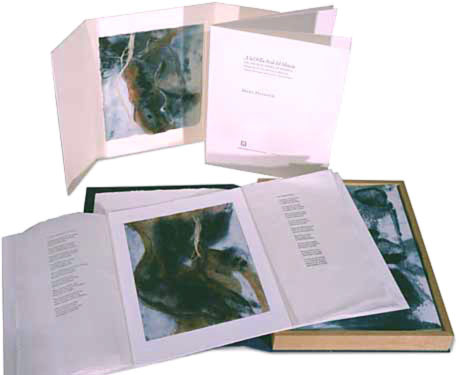

Indigo Series: Pulp painting at Dieu Donne
This series is a prelude to the pulp-painted
wraps used to contain the 12 folios of poetry and images in my book,
"On the Blue Shore of Silence"
Poems of the Sea by Pablo Neruda
I worked with Pat Almonrode at Dieu Donne mill. Pat used a 24" x 36" screen and once he lifted the pulp out of the vat on the screen, it drained slowly and then we both couched it onto a flat surface padded with felt. I then took the screen and inserted a template which gave a "spine" to the abstract design.
On to the screen I "painted" with linen pulp that I had colored a deep indigo blue. I used squirt bottles, a dustpan. a hose with fine spray nozzle. Next we couched this screen onto the surface of the pure white cotton rag paper. If it slipped, which was easy to do, as everything in this state is the consistency of cold porridge, I would lose everything and have to start over. If it did not, I gently lifted the screen off and continued to work. I found that I could create layers resembling washes simply by controlling how much I diluted the pigmented pulp. Ultimately I used my breath to blow the slimy pulp around on the pure white of the newly- formed sheet. Finally we covered the completed painting with wet felts and I began the process anew. Once we had a stack of 15 or so, we would press them in a 6 thousand-pound hydraulic press. Then it would get sent to the drying area where it was hand separated from the felt and left to dry for 24 hours on blotter paper, under pressure of weights.
The uncanny thing was that I had unwittingly mixed a color of blue that blueprints are printed in, and that most film does not read as blue. Two attempts to shoot slide documentation of this series gave me boxes of slides that looked like black and white film. To me they bring to mind X-rays or blueprints.
 |
 |

|
 |
 |
 |

